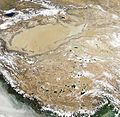Файл:Jewel-Toned Lakes of the Qinghai-Tibet Plateau.jpg
Перейти до навігації
Перейти до пошуку

Розмір при попередньому перегляді: 615 × 600 пікселів. Інші роздільності: 246 × 240 пікселів | 492 × 480 пікселів | 788 × 768 пікселів | 1050 × 1024 пікселів | 2101 × 2048 пікселів | 7940 × 7740 пікселів.
Повна роздільність (7940 × 7740 пікселів, розмір файлу: 7 МБ, MIME-тип: image/jpeg)
Історія файлу
Клацніть на дату/час, щоб переглянути, як тоді виглядав файл.
| Дата/час | Мініатюра | Розмір об'єкта | Користувач | Коментар | |
|---|---|---|---|---|---|
| поточний | 13:22, 26 січня 2013 |  | 7940 × 7740 (7 МБ) | Slick-o-bot | Bot: convert to a non-interlaced jpeg (see bug #17645) |
| 10:33, 26 листопада 2010 |  | 7940 × 7740 (6,88 МБ) | Originalwana | {{Information |Description={{en|1=Natural-colour image of the Tibetan Plateau. The Qinghai-Tibet Plateau not only gives rise to most of Asia’s major rivers, it also holds a constellation of salt- and freshwater lakes. Due to differences in depth |
Використання файлу
Така сторінка використовує цей файл:
Глобальне використання файлу
Цей файл використовують такі інші вікі:
- Використання в ast.wikipedia.org
- Використання в bo.wikipedia.org
- Використання в ca.wikipedia.org
- Використання в de.wikipedia.org
- Використання в en.wikipedia.org
- Використання в es.wikipedia.org
- Використання в sl.wikipedia.org
- Використання в sr.wikipedia.org

